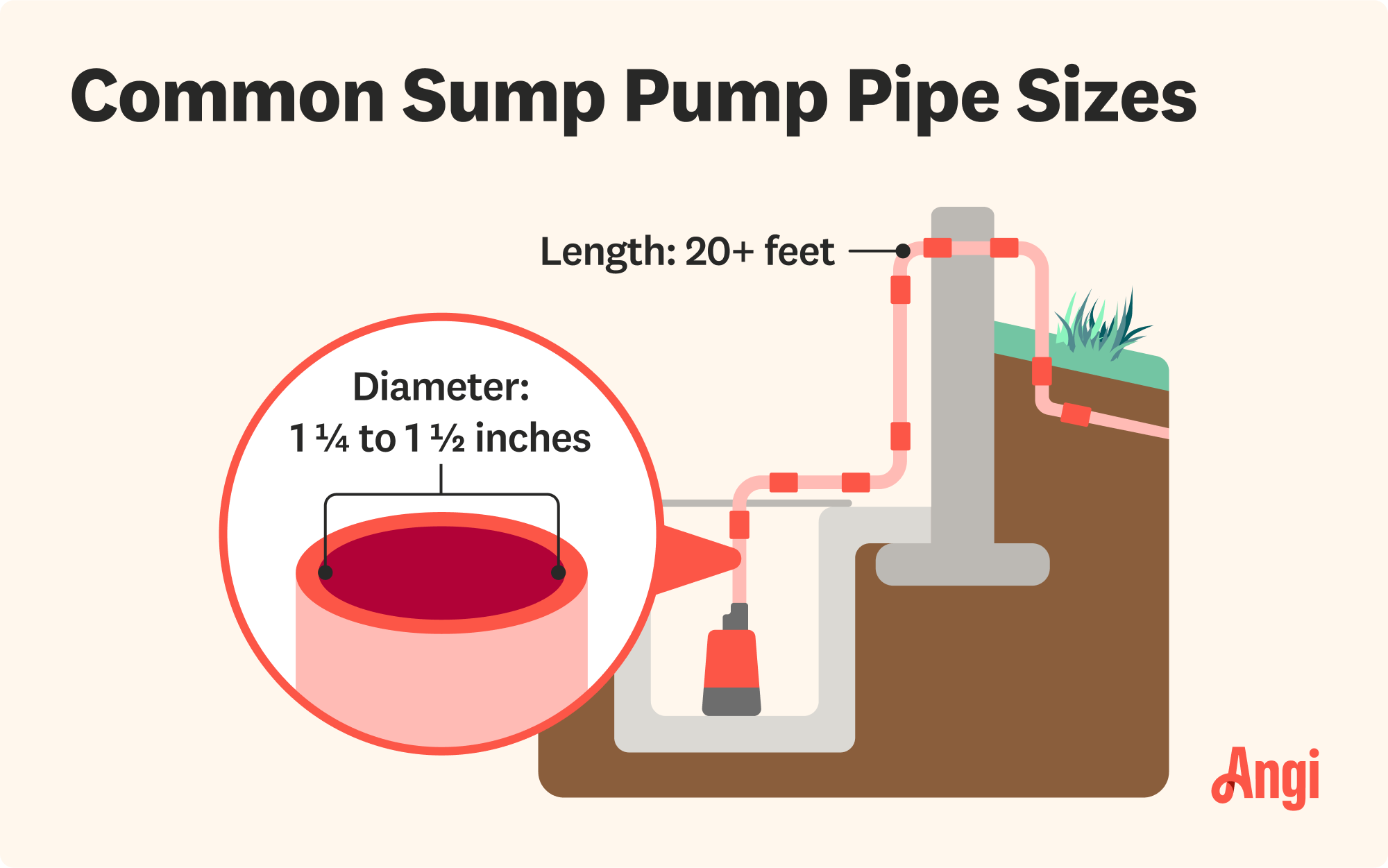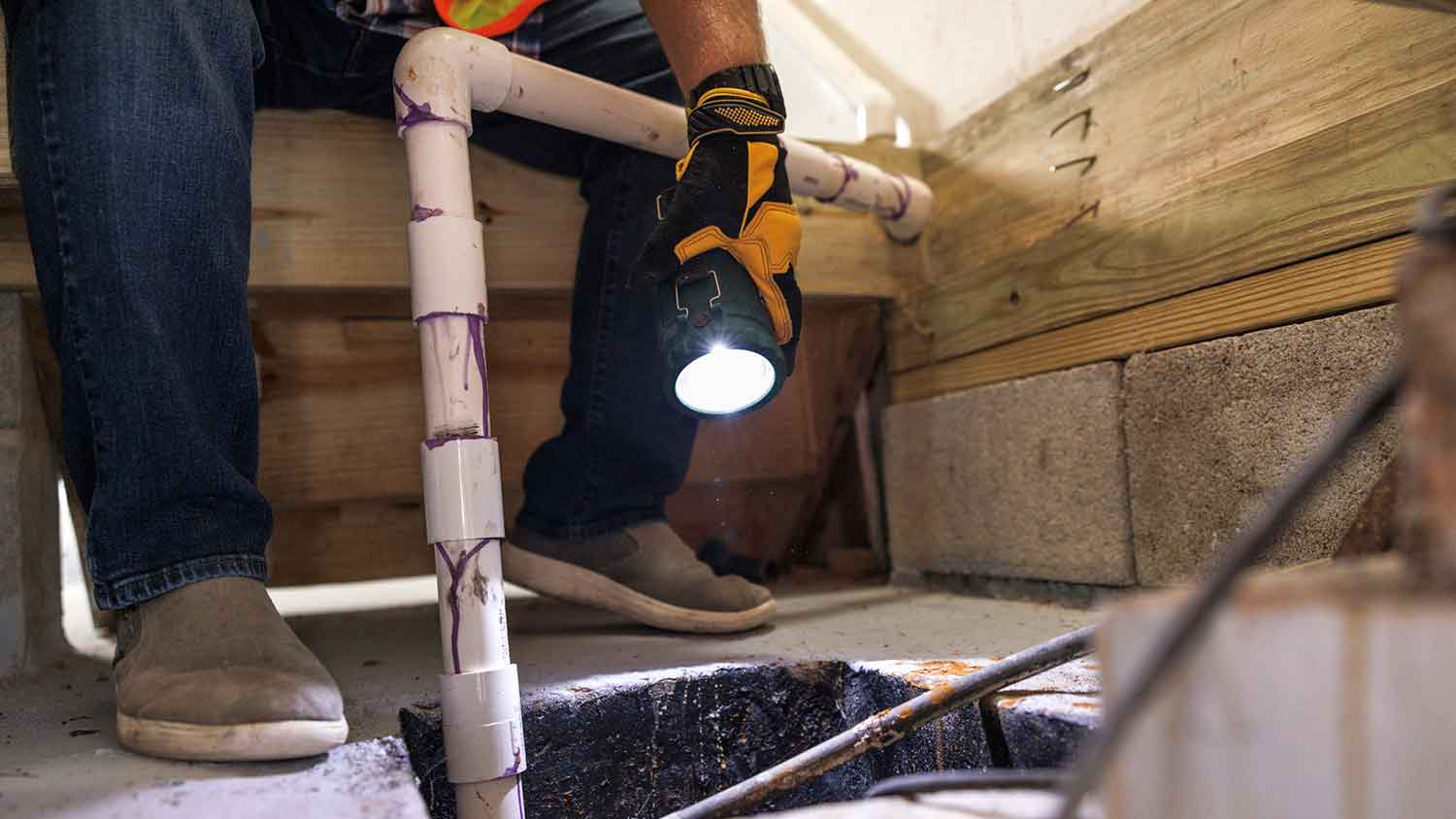
Cisterns can save you money and help the environment. So what’s the cost of a cistern and how does it compare to other rainwater collection systems?
The proper pipe size will help your sump pump go with the flow


Also known as discharge lines, sump pump pipes commonly measure 1 1/4 inches to 1 1/2 inches in interior diameter.
Sump pump pipe lengths vary, but they’re at least 20 feet long on average.
Your sump pump’s pipe should discharge water 10 to 20 feet away from your foundation.
If your pipe is the wrong size, your sump pump may wear out faster.
Your sump pump has the tough job of pumping excess water out of your home to prevent flooding and water damage, but the pump doesn’t operate on its own. For the process to run effectively, the sump pump must be connected to the right-sized discharge pipe. So, what size pipe is best for a sump pump? Dive into our ultimate guide to sump pump pipe sizes (and the factors that determine the best pipe size).

When you buy a sump pump, it will have a built-in fitting for a discharge pipe. These openings are between 1 1/4 inches and 1 1/2 inches in interior diameter.
On the other hand, sump pump pipe lengths vary widely. A discharge line’s length will depend on several factors, including:
The sump pump’s location within your home
Your property’s terrain and landscape
Local laws and regulations
With that said, the pipe must be long enough to extend from your sump pump to the outside of your home. It should also discharge water between 10 and 20 feet away from your foundation. Because of this, sump pump pipes often measure at least 20 feet in length.

Since the fitting sizes on sump pumps are fairly consistent, it shouldn’t be too difficult to pick the right pipe diameter. In fact, all you need to do is check the manufacturer’s instructions, which should list the pump’s fitting size. Then, you can buy piping that matches those dimensions.
Calculating pipe length is more complicated. For one, the right length depends on the specifics of your property. On top of that, you also need to understand the pipe’s actual length versus its equivalent length. The equivalent length takes into account the straight length of the pipe itself in addition to the elbows and check valves.
For those reasons, we suggest having a local sump pump installer determine the right pipe length for your home. And unless you have plumbing experience, it’s best to have them install the discharge line, too. If you try to DIY the job and make a mistake, you run the risk of burst pipes, flooding, and water damage, which could cost more to fix than you would’ve spent on professional labor in the first place.
When choosing the right size for your discharge line, a plumber or sump pump pro will consider the following factors:
A sump pump’s pipe size needs to align with the pump’s capacity. If the pipe’s diameter is too small, it can reduce the flow of water, making the pump less efficient than if it were connected to a larger pipe. It can also force your sump pump to run constantly, potentially reducing its life span.
Pros install sump pumps in the lowest part of your home—often a basement or crawl space. The distance between the installation location and the outdoor discharge point directly affects the required length of your sump pump pipe.
Your pro will need to position a discharge line between 10 and 20 feet away from your home’s foundation. The exact distance you select will influence the length of the pipe.
Also, if you bury your sump pump discharge line underground, the depth you choose will also impact the total pipe length. Deeper installations will require additional pipe.
Before picking a discharge location or pipe size, make sure to check your local building codes. Most areas require you to divert your sump pump drainage away from sidewalks and streets. In this case, you’ll need more pipe.
Installing the wrong-sized discharge line can lead to several sump pump issues. A pipe that’s too small in diameter can make your pump less efficient and push it to run more than it should.
Selecting the incorrect pipe length can also cause problems. If the line isn’t long enough, it could recirculate the discharged water back into your sump pump (and put unnecessary strain on it). But if the pipe is too long, your pump’s motor will end up working harder to move water across that distance.
If you think that your pipe is the wrong size, call a professional who installs sump pumps. They can check your entire sump pump system to make sure that it’s working properly and discharging to an appropriate location. If not, they’ll recommend what to do next—whether that’s replacing your sump pump, installing new piping, or moving the discharge point.
Mayflower was an excellent choice for the complete renovation of my condominium. They knew exactly how to deal with the complexities of the condo building and management to make the project very smooth, easy and done right. From start to finish, everyone was incredibly helpful and their...
Tony was very professional and personable. He explained the damage he saw and reassured me the work to be performed. On the day of the visit he was punctual, courteous and exceeded my expectations while sharing information.
We contracted NY Galaxy General Contracting to complete a recent, entire home renovation, this included bedroom, living room, kitchen and bathrooms. The project was seamless and completed just in time.I highly recommend them as they are extremely professional and truly care about their...
Alex and his crew are great! I contracted them to move my dad and they went above and beyond!
Excellent sales staff and installer. Easy to work with. I appreciated that my current system was able to be activated and used.
They are very professional and well mannered team in doing their job. I love the quality of their work in my garden. Thank You Kuztomized Kurbing.
I needed a kitchen and bathroom remodeling and these guys were the best people I could choose. They took my vision and brought it to life! Amazing customer service.
I used them close to 30 years. The company is well run organization and uses much modern technology to keep the clients and their workers up to date. Their men were very courteous and careful in their work. Their Maintenance Department were very efficient and very good at problem solving....
From average costs to expert advice, get all the answers you need to get your job done.

Cisterns can save you money and help the environment. So what’s the cost of a cistern and how does it compare to other rainwater collection systems?

Well pumps require electricity to operate and can affect your monthly bill. Learn about the factors that impact the average cost to run a well pump per month.

When your water system isn’t working as intended, it’s time to repair your well pump. This cost guide will break down well pump repair costs and the parts involved.

A pressure tank keeps your well system running smoothly. Follow this guide to determine the specific well pressure tank size needed for your home.

Is your water pressure too low? Learn what pressure your well tank should be to get your system running smoothly and your showers and faucets back on track.

Low water pressure is frustrating. That’s why we made this guide to help you learn how to get more pressure from your well for a shower that feels just right.